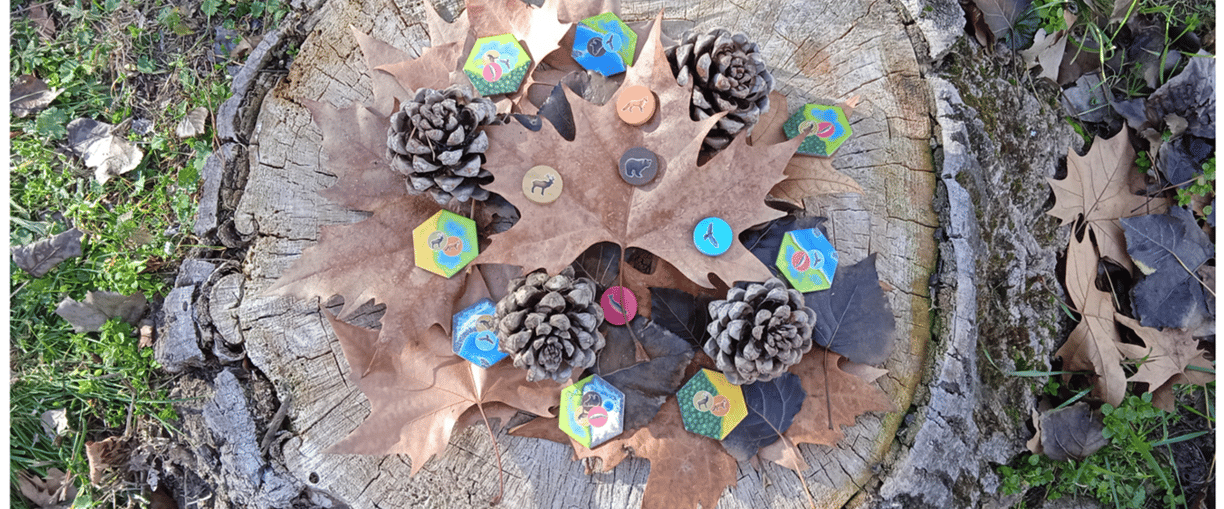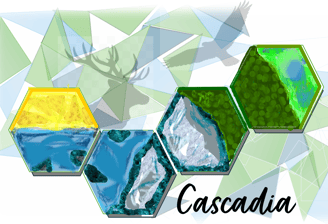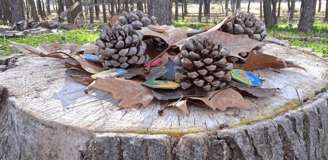The Lure of Cascadia
A review of Cascadia
Chris Sanderson


It was there, in the elk under an azure sky, in the clacking of pebbles rolling down a scarped mountain slope.
The lure of Cascadia. I was captivated.
It didn't matter that the elk was part of the game box's artwork, or that the clacking was really the sound of the guy on the promotional video rummaging through the tokens bag. It still added to the Cascadian mystique, the call of a faraway, almost mythical place - one we would most likely never visit.
Would this be our next game?
I'd been feeling the itch for a while, the thirst for a new gaming experience. My wife is my chief playing companion, but many of our previous games cast us as opponents more than partners. As a multisolitaire tile-layer, however, Cascadia promised the chance to roll out new worlds unhindered by direct rivalry.
Persuaded by the welter of glowing reviews, we took the plunge and embarked on what quickly became our first real shared gaming journey.
Because, above all, that's what Cascadia has been for us - a beautiful, absorbing journey. Nearly two years have passed, and I can say we have visited - are still visiting - Cascadia, our Cascadia.
Together, we have scaled the heights where hawks survey everything - especially other hawks.
We have marvelled at the elk herds straddling entire habitat corridors.
We have formed perfect salmon chains and identical groups of bears carefully segregated from each other.
We have slid habitats into place with architectural mastery.
And we keep on and on. We open the box, and Cascadia exists again.
In my more absurd moments, I sometimes imagine meeting someone from Cascadia. I go goggle-eyed and babble stuff like, "Wow, a person from Cascadia! Tell me, do the elks there really stand around in weird geometric formations? And
the hawks - do they all do that 'line of vision' thing?"
No, don't laugh. It was just like that when my family visited the place where the TV series Downton Abbey was filmed. We couldn't help asking the staff there if the actors were 'like that in real life'.
We want real, even in a series, even in a game.
But how real can a game really be? I'm not talking about theme. I'm talking about a genuine connection with reality.
Does Cascadia the game connect with Cascadia the bioregion? Is there a point where both mystically coincide?
I dream so.
Just take the name, for example.
Cascadia.
I say it, and I'm already seeing spray-veils of waterfalls, promises of cascading effects. The name itself inspires calmness, peace. It's kind of hard to get seriously frustrated playing a game called 'Cascadia', even when the luck goes against you.
Like most folks, I don't take kindly to luck randomly sabotaging my plans. When I've invested time and money in a game, I expect a bit of consideration, my allotted dose of enjoyment. Don't tell me I'm just unlucky.
But in Cascadia, I never really suffer that stab of randomness that pure luck inflicts. Luck is there, of course, in the draw of the tiles and counters, but it is veiled by the Cascadian mists.
Here, luck plays the part of nature's unpredictability. So when those much-needed bears fail to come out of the bag, that doesn't feel like bad luck, it feels more like bears being bears. "Maybe they're just hibernating," I joke. "Yeh, 'cos bears hibernate, don't they? And salmon have their seasons, right? So who am I to get annoyed when they don't answer my petty demands? This is Cascadia, this is nature! A bit of humility, please!"
I often end up muttering this kind of thing under my breath during play. Sometimes my wife mumbles back her assent, though too often she's busy muttering her own thoughts. "Oh, can't I just twist that tile the other way so it fits with this new one?" The answer is always "No'", of course, unless I'm also in a spot and in need of a favour. (Don't be scandalised - we only commit such a crime when we've both blown our chances of achieving our objectives.)
Our Cascadian hikes are often spent like this, in a gentle communion of muttering. Which is what makes it a journey rather than a rivalry. We're not after the winning score; we're after that elusive consonance of puzzle with nature. And there is a lot of that along the way.
Take the habitats. Tile-laying has never been so organic. Watching habitats evolve, it's easy to forget that this is basically a puzzle. As sweeping forests blend with threads of intertwining mountains and rivers, we breathe the air of balance and consonance. Forces of nature and logic fuse in a colourful dance of biospheric patterns.
We love watching those patterns grow. Closed clusters of fiercely jealous bears form among serene elk herds, peppered with the occasional snooping, subversive fox and interlaced by the exuberant flow of salmon - all overarched by that clear-eyed geometry of hawks.
We love how objectives and animals alter priorities and behaviours. Now, suddenly, the elks are the geometrically arranged ones, and foxes unwittingly become a unifying force. Everything ebbs and flows, determined and guided by the shifting interactions of tokens, tiles and goals.


Above all, it's perhaps the element of duality that keeps us so passionate about our journey. It's the duality of balancing animals with habitats. You're overlaying your ideal animal arrangements on your ideal habitats carpet, so something usually has to give way. Completing that bear trio will split up your carefully constructed mountain range. What do you do, sacrifice bears or mountains?
It's that duality that most strikes a chord in me. Because it is a mirror image of my own.
The duality of right-brain, left-brain. Of poetry and puzzle, creativity versus reason. My inner reality and out-there reality.
Duality. It's what would do my head in, if my head wasn't so in tune with all this intoxicating charm.
Take, for example, scenario 13 - an unusually puzzly one for me. (Dozens of attempts and I still haven't cracked it, sigh.) Here, hawks are supposed to stick like limpets to elks, but not vice versa. A puzzle in extremis, it seems, making animals into a kind of strung-out molecular structure (see the formula E8H5, where E = elk, H = hawk).
Nothing very Cascadian there, right? At the same time, though, there's a wildlife documentary feel about the scene. Picture it: a bunch of hawks ganging up on a herd of elks (maybe they spotted a lame elk calf limping behind?) Those poor elks were just minding their own business, trying to string themselves out to get max points (sorry, that was the puzzle part), then an elite force of visually connected hawks comes swooping down behind their backs.
An echo of natural processes, perhaps? What is that? Poetic puzzliness? Puzzly in Motion?
It's seeking that fusion of disparate elements that keeps us on our trek. Even when the going gets muddy, we still have the innate beauty of Cascadia before us, inviting us to curl and bend its habitats like carpets under the feet of crystalline patterns of animals. It soothes, it rewards, it humbles.
And it challenges.
At least it challenges me.
Especially over my view of foxes.
I wish to make a confession.
For decades, I have been a fox-despiser. Bedtime stories like The Gingerbread Man and Pinocchio have left their mark. Foxes have been portrayed as insidious, Machiavellian vagrants, and I have gone along with the drift.
But Cascadia has begun to change all that. It is possible that this game is curing my contempt for foxes.
Not initially, mind. In those early games, the tokens bag seemed to contain nothing but foxes. And like in real life, no one wanted the pesky creatures around. You wanted a hawk or a salmon, but there were two foxes that no one would pick up. Usually two. They were sneaky like that. Three, and they'd go in the bag for replacing. Four, and no questions, off they went. But two?
What was going off inside that bag? Foxes seemed to reproduce there at will and sneakily nose their way into our grasp.
Things though have begun to change. Foxes are still foxes, but I have begun to listen to the hidden consonance of Cascadia. And I hear a deeper, pre-pinocchian truth.
Foxes don't particularly mind what species they hang around. They're not proud, not aloof, like some other animals. They're flexible, they're sociable.
Certainly Cascadia rewards their sociability. How many times lately have I placed a single fox in the middle of the multitude and hit a mini jackpot? I've been finding that I'm getting a decent bunch of points just from careful fox placement. They're fast becoming the key, the vital supporting act.


And that's how the game is. You leave it either elated or humbled - and it's difficult to say which is better. Too much elation spoils the boardgamer, as they say.
Thanks to you, designers, for gifting us this beautifully crafted game; for giving our imagination the tools to fly, to dream. For giving us the possibility of a shared journey, the seed of our own Cascadia.
Who knows, we might even visit the real place one of these days ...


This is just one example of the change I am undergoing. The acceptance that nature and the game cannot be dictated to or imposed upon. This is not imposition, it's art, it's about coaxing a pattern out of what's happening. Which requires humility, flexibility. Nature can't be shaped to my prejudices, nor to my will.
There's something totally right about the way Cascadia works. It refuses to bend to my schemes; I must bend to its unpredictable ways. It allows the beauty of an unfolding habitat that you're kind of controlling, but which must claim its own logic. How natural that nature won't ever follow my dictates! Nor will elks come out just when I want them! Nor is there always a prefabbed habitat waiting to accommodate my salmon on demand! Nature dictates, I adapt. That's how it should be.
Hi, I am Chris Sanderson, an Englishman living near Madrid, Spain. Please send me your comments by email, or in BoardGameGeek through the links at the end of each game review.
© 2025. All rights reserved.